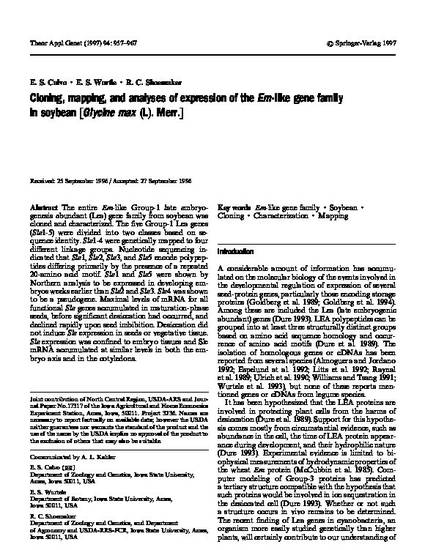
Article
Cloning, mapping, and analyses of expression of the Em-like gene family in soybean [Glycine max (L). Merr.]
Theoretical and Applied Genetics
Document Type
Article
Disciplines
Publication Version
Published Version
Publication Date
6-1-1997
DOI
10.1007/s001220050501
Abstract
The entire Em-like Group-1 late embryogenesis abundant (Lea) gene family from soybean was cloned and characterized. The five Group-1 Lea genes (Sle1-5) were divided into two classes based on sequence identity. Sle1-4 were genetically mapped to four different linkage groups. Nucleotide sequencing indicated that Sle1, Sle2, Sle3, and Sle5 encode polypeptides differing primarily by the presence of a repeated 20-amino acid motif. Sle1 and Sle5 were shown by Northern analysis to be expressed in developing embryos weeks earlier than Sle2 and Sle3. Sle4 was shown to be a pseudogene. Maximal levels of mRNA for all functional Sle genes accumulated in maturation-phase seeds, before significant desiccation had occurred, and declined rapidly upon seed imbibition. Desiccation did not induce Sle expression in seeds or vegetative tissue. Sle expression was confined to embryo tissues and Sle mRNA accumulated at similar levels in both the embryo axis and in the cotyledons.
Rights
Works produced by employees of the U.S. Government as part of their official duties are not copyrighted within the U.S. The content of this document is not copyrighted.
Language
en
File Format
application/pdf
Citation Information
E. S. Calvo, E. S. Wurtele and R. C. Shoemaker. "Cloning, mapping, and analyses of expression of the Em-like gene family in soybean [Glycine max (L). Merr.]" Theoretical and Applied Genetics Vol. 94 Iss. 8 (1997) p. 957 - 967 Available at: http://works.bepress.com/eve-wurtele/27/

This article is from Theoretical and Applied Genetics 94 (1997): 957, doi: 10.1007/s001220050501.